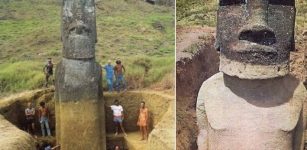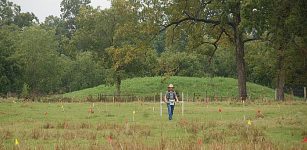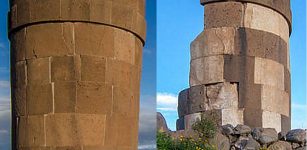Grave Creek Mound – One Of North America’s Most Curious Ancient Monuments
Ellen Lloyd - AncientPages.com - The Grave Creek Mound (also known as the Mammoth Mound) is located in Moundsville, West Virginia. It is one of the most curious ancient monuments in North America.
At first sight, it appears to be just one of many mounds we find in the country, but there are several reasons why this particular mound is unique.
This is the biggest mound the Adena people have ever constructed. Constructing the hill required the movement of more than 60,000 tons of earth—about three million basket loads of earth!
North America had four known mound-building cultures - the Poverty Point, Adena, Hopewell, and Mississippian cultures. Their names, usually taken from where relics of their societies were found, refer to a way of life.
The Adena lived in parts of present-day Ohio, Indiana, Wisconsin, West Virginia, Kentucky, New York, Pennsylvania, and Maryland.
The earliest known photo of the Mound - Credit: W.S.Keyser
It's important to point out that the Adena culture is not the name of any American Indian tribe. Researchers have yet to learn what these people called themselves. Their name originates from the estate of Ohio Governor Thomas Worthington, which he called Adena.
The Adena culture flourished between 1000 and 200 B.C. At its height, it reached a population of between eight and seventeen million.
Moundsville, West Virginia, just outside of Wheeling, is home to the Grave Creek Mound. Credit: Adobe Stock - aceshot
Why The Grave Creek Mound Is Unusual
Archaeologists and historians think the Adena people were the first culture in North America to construct earthen mounds in which they regularly buried their dead. The mounds were often shaped in animal or geometric designs.
Standing 65 feet (19.5 m) tall with an outer circumference of 910 feet (273 m), the mound was an awe-inspiring sight, but it was certainly not built overnight.
Grave Creek Mound was constructed in stages over 100 years between 150 and 250 B.C.
What is unusual about this mound is its size. The Adena people in the area constructed several other burial mounds. However, these mounds are much smaller, ranging from 20 to 300 feet (6 to 90 m) in diameter.
Why was it so crucial for the Adena people to build a massive mound like the Grave Creek Mound?
The Grave Creek Stone - Credit: Smithsonian Institution - Public Domain
We do know that the Adena buried their dead in prominent mounds that archaeologists believe may have served as territorial markers. Sometimes, the mounds were accompanied by small, circular earthen enclosures that may have surrounded ritual spaces.
Archaeologists have discovered several ancient objects inside the burial mounds. Deceased individuals were either cremated or laid on their backs and were often surrounded by artifacts such as jewelry and tools. Most likely, the Adena people believed the deceased would need these objects in their afterlife.
The Controversial Grave Creek Stone
The Grave Creek Mound was first discovered in the late 1700s by English immigrant Joseph Tomlinson, who built a house just before the mound.
About 60 years later, Tomlinson's descendant Jesse started digging tunnels into the mound and discovered two burial chambers filled with skeletons, jewelry, and seashells.
An artistic rendering of the Grave Creek Stone on display at the Grave Creek Mound and Archaeological Complex in Moundsville, West Virginia. Photo courtesy of Rebecca Taylor (fair use)
The controversial Grave Creek Stone was unearthed in 1838 during the burial mound excavation. A small sandstone disk was inscribed on one side with some twenty-five characters.
According to Henry Rowe Schoolcraft, a renowned geologist who visited the site in 1843, the Grave Creek Stone was discovered in the upper vault, along with seventeen hundred beads, five hundred seashells, five copper bracelets, and one hundred and fifty plates of mica. It was "a small flat stone, of an ovate shape, containing an inscription in unknown characters."
It is impossible to say today whether Grave Creek Stone was genuine or a fake because its whereabouts are unknown.
If genuine, it could provide evidence the Adena people mastered a primitive alphabet.
It's likely just a coincidence, but the Grave Creek Mound is remarkably similar in design to the prehistoric earthen Silbury Hill.
Written by Ellen Lloyd – AncientPages.com
First version of this article was published on January 10, 2018
Copyright © AncientPages.com All rights reserved. This material may not be published, broadcast, rewritten or redistributed in whole or part without the express written permission of AncientPages.com
Expand for referencesM. C Read - Inscribed stone of Grave Creek mound: Report of M.C. Reid of Hudson, Ohio
Greg Roza - The Adena, Hopewell, and Fort Ancient of Ohio (The Library of Native Americans)
More From Ancient Pages
-
 Sacred Hidden Buyan Island And The Mysterious Alatyr Stone With Healing Powers May Have Existed
Featured Stories | Mar 22, 2018
Sacred Hidden Buyan Island And The Mysterious Alatyr Stone With Healing Powers May Have Existed
Featured Stories | Mar 22, 2018 -
 Easter Island’s Statues Reveal Bodies Covered With Unknown Ancient Petroglyphs
Archaeology | Jan 21, 2014
Easter Island’s Statues Reveal Bodies Covered With Unknown Ancient Petroglyphs
Archaeology | Jan 21, 2014 -
 Pharaonic Water Wells Discovered For The First Time Near ‘Horus Road’ In Sinai, Egypt
Archaeology | Mar 1, 2022
Pharaonic Water Wells Discovered For The First Time Near ‘Horus Road’ In Sinai, Egypt
Archaeology | Mar 1, 2022 -
 World’s First Documented Labor Strike Took Place In Ancient Egypt In The 12th Century BC
Ancient History Facts | Jun 7, 2016
World’s First Documented Labor Strike Took Place In Ancient Egypt In The 12th Century BC
Ancient History Facts | Jun 7, 2016 -
 Remains at Crenshaw Site Are Local, Ancestors Of Caddo – New Study
Archaeology | Jun 15, 2023
Remains at Crenshaw Site Are Local, Ancestors Of Caddo – New Study
Archaeology | Jun 15, 2023 -
 Mysterious Mustatils- Giant 7,000-Year-Old Stone Monuments In Saudi Arabia Baffle Scientists
Archaeology | Aug 19, 2020
Mysterious Mustatils- Giant 7,000-Year-Old Stone Monuments In Saudi Arabia Baffle Scientists
Archaeology | Aug 19, 2020 -
 Why Were Medieval People Easily Offended And Scared Of Rumors?
Ancient History Facts | Oct 14, 2019
Why Were Medieval People Easily Offended And Scared Of Rumors?
Ancient History Facts | Oct 14, 2019 -
 Ancestor Of Italian Pizza Depicted On Fresco In Pompeii
Archaeology | Jun 28, 2023
Ancestor Of Italian Pizza Depicted On Fresco In Pompeii
Archaeology | Jun 28, 2023 -
 Is The Mystery Of Controversial Phaistos Disk Solved?
Archaeology | Dec 17, 2015
Is The Mystery Of Controversial Phaistos Disk Solved?
Archaeology | Dec 17, 2015 -
 Tullus Hostilius: Warrior King Of Rome, Who Succeeded Numa Pompilius And Feared Prophecies
Featured Stories | Mar 6, 2019
Tullus Hostilius: Warrior King Of Rome, Who Succeeded Numa Pompilius And Feared Prophecies
Featured Stories | Mar 6, 2019 -
 Andlang – Spiritual Heaven And Shelter For The Dead After Ragnarok In Norse Mythology
Featured Stories | Aug 23, 2019
Andlang – Spiritual Heaven And Shelter For The Dead After Ragnarok In Norse Mythology
Featured Stories | Aug 23, 2019 -
 Unique Statue Of Roman Emperor Trajan Unearthed In Ancient City Of Laodicea,Turkey
Archaeology | Apr 12, 2019
Unique Statue Of Roman Emperor Trajan Unearthed In Ancient City Of Laodicea,Turkey
Archaeology | Apr 12, 2019 -
 Negev Desert’s Ancient Site Tells Story About Humans, Neanderthals Coexistence
Archaeology | Jun 19, 2021
Negev Desert’s Ancient Site Tells Story About Humans, Neanderthals Coexistence
Archaeology | Jun 19, 2021 -
 Unique Gold Votive Plaque Found At Fort Apsaros Reveals Evidence Of A Mysterious Roman Sect
Archaeology | Nov 14, 2024
Unique Gold Votive Plaque Found At Fort Apsaros Reveals Evidence Of A Mysterious Roman Sect
Archaeology | Nov 14, 2024 -
 Image Of The Day: Huge, Cylindrical Chullpa Tombs Of Sillustani, Peru
Civilizations | Sep 8, 2015
Image Of The Day: Huge, Cylindrical Chullpa Tombs Of Sillustani, Peru
Civilizations | Sep 8, 2015 -
 3-D Reconstructions Of Three Wooden Boats Found At Ancient Port In Italy
Archaeology | Jun 23, 2020
3-D Reconstructions Of Three Wooden Boats Found At Ancient Port In Italy
Archaeology | Jun 23, 2020 -
 Mysterious Manuscript 512 Reveals Lost Ancient City Hidden In The Amazon Jungle
Ancient Mysteries | Jan 28, 2018
Mysterious Manuscript 512 Reveals Lost Ancient City Hidden In The Amazon Jungle
Ancient Mysteries | Jan 28, 2018 -
 Huge Ancient Ceramic Workshop With Hundreds Of Stunning Artifacts Solves An Archaeological Mystery In Israel
Archaeology | Dec 14, 2020
Huge Ancient Ceramic Workshop With Hundreds Of Stunning Artifacts Solves An Archaeological Mystery In Israel
Archaeology | Dec 14, 2020 -
 Thousands Of Sacred ‘Images’ With Unknown Signs Hidden In A Monastery Could Be World’s Oldest Alphabet
Ancient Mysteries | Jun 9, 2021
Thousands Of Sacred ‘Images’ With Unknown Signs Hidden In A Monastery Could Be World’s Oldest Alphabet
Ancient Mysteries | Jun 9, 2021 -
 Unexplained Mysteries Of The Superstition Mountains – A Gateway To Other Worlds?
Featured Stories | Dec 15, 2020
Unexplained Mysteries Of The Superstition Mountains – A Gateway To Other Worlds?
Featured Stories | Dec 15, 2020





